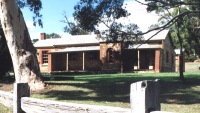Willunga Courthouse Museum

In a picturesque setting at the top of High Street in historic Willunga, the Courthouse complex stands on the original Government Reserve where, in 1839, police and surveyors arrived to help the first settlers take up the land. Displaced Aboriginals camped here and received rations. Today's visitors experience the authentic C19th Courtroom (complete with prisoner's box, jury box and witness box), adjoining cells and exercise yard, attached police residence and nearby stables. Past deeds and misdeeds are vividly brought to life - the heroism of the mounted constables, the controversial female Immigration Depot set up in 1855, the early slate quarrying heritage of the Willunga district. Fascinating family and local history records can be browsed.
Located on the Fleurieu Peninsula, in the McLaren Vale Wine Region, the Courthouse is popular with families, researchers and historical enthusiasts, and caters for group visits and curriculum activities by school groups and tourism students. The grounds provide a charming setting for outdoor weddings and picnics, while the Nature Reserve, where police horses once grazed, is a remnant of the Grey box grassy woodland once common on the foothills of the rugged Willunga range. A self-guided Nature Trail is under construction. Historic Willunga Township tours are available.
Items
Stables

Cells

